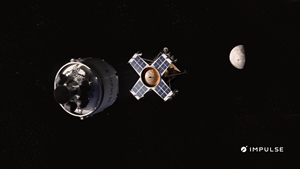Impulse Space Unveils Proposed Mission Architecture to Deliver More Mass to the Lunar Surface
Plan leverages Impulse’s kick stage, Helios, and a new Impulse-built lunar lander to transport up to 3 tons per mission to the Moon, to support the rapid build out of a sustained American lunar presence
REDONDO BEACH, Calif., Oct. 14, 2025 (GLOBE NEWSWIRE) -- Impulse Space, the leader for in-space mobility, today unveiled a proposed mission architecture for delivering multiple tons of cargo to the Moon in the near term. The plan combines Impulse’s existing Helios kick stage and a new lunar lander, to be developed in-house. Launched on a medium- or heavy-lift rocket, this combination could take approximately 3 tons of cargo to the Moon.
The proposal is a response to an existing gap in lunar cargo delivery capabilities, specifically for payloads ranging from 0.5 to 13 tons. Today, NASA’s Commercial Lunar Payload Services (CLPS) program is limited to small-scale deliveries on the order of hundreds of kilograms, and the Human Landing System (HLS) vehicles (which target large payloads required for human flight) are still in development. In the near term, a landing system capable of delivering midsized payloads could be used for equipment like lunar terrain vehicles or power generators, supporting the build out of a sustainable lunar presence.
“Traveling to and landing on the Moon requires spacecraft with tightly integrated, reliable systems—from avionics to propulsion to communications,” said Tom Mueller, founder and CEO of Impulse Space. “We’ve already demonstrated that our technologies are up to the task, and this architecture represents the next logical step for advancing in-space mobility beyond near-Earth orbit.”
Proposed Mission Overview
Under the plan, Helios would launch on a standard medium- or heavy-lift rocket. Impulse's lunar lander would ride as a payload on Helios. Once Helios and the lander are deployed in Low Earth Orbit (LEO), Helios serves as a cruise stage, transporting the lander to low lunar orbit within one week. The lunar lander then separates from Helios and descends to the surface of the Moon. By taking advantage of Helios’s high delta-v capabilities, this proposed mission architecture doesn’t require in-space refueling.
With this Helios and in-house lander combination, Impulse estimates delivering up to 6 tons of payload mass to the Moon (across two missions) per year starting in 2028 at a cost-effective price point.
Impulse’s Advantage
The plan leverages existing and flight-proven technologies, accelerating time to execution and reducing risk. Examples include:
- Use of existing, commercially available launch vehicles
- Use of subsystems and components that already have flight heritage or are in advanced development stages. By 2028, Helios will have flown multiple missions.
The team has already begun work on the engine for a lunar lander, which will use a nitrous and ethane bipropellant—the same combination already used successfully in space on Impulse’s Mira vehicle. The engine is designed to be highly throttleable, restartable, and have a high specific impulse (Isp).
“We’re confident in our ability to execute on this plan based on our track record of rapidly and successfully developing new spacecraft, such as taking Mira from clean-sheet design to orbit in less than 15 months,” said Mueller. “With Mira’s Saiph thrusters, we’ve already demonstrated the capability to operate highly efficient, rapidly restartable engines in space.”
Supporting America’s Lunar Objectives
By expanding medium-class lunar cargo delivery capabilities, Impulse aims to support NASA’s long-term goal of establishing a permanent human presence on the Moon. Reliable, near-term payload transportation will also accelerate the broader space economy.
“The Moon can play an important role in advancing American leadership in space, as well as benefitting all of humanity from the perspective of scientific exploration,” said Mueller. “Impulse is committed to supporting that effort by delivering innovative, cost-effective solutions that extend our reach beyond Earth.”
About Impulse Space
Impulse Space, the in-space mobility leader, is accelerating our future beyond Earth beginning with its fleet of cost-effective, high-performance space vehicles: Helios and Mira. The Helios kick stage unlocks high-energy orbits with its powerful Deneb engine, rapidly transporting payloads from LEO to MEO, GEO, heliocentric, lunar, and other planetary orbits. The flight-proven Mira enables precise maneuverability and rapid responsiveness for hosting, deployment, and rendezvous and proximity operations (RPO) across any orbit. Founded by Tom Mueller and led by a team of industry pioneers, Impulse Space is transforming in-space mobility by reliably and rapidly getting customers where they want to go. And they're just getting started. For more information, visit www.impulsespace.com
Contact
press@impulsespace.com
A photo accompanying this announcement is available at https://www.globenewswire.com/NewsRoom/AttachmentNg/51a28b75-7399-46f2-b220-0e27f33b7b34

Lunar Lander Deploying from Helios
Helios transports, then deploys, the Impulse-made Lunar Lander in lunar orbit. The Lunar Lander completes a breaking burn, then descends toward the Moon's surface. The Helios kick stage is seen in the foreground, with the lander behind it. With its powerful propulsive capabilities, Helios enables a greater amount of mass to land on the Moon while leveraging a medium- or heavy-lift launch vehicle.
Legal Disclaimer:
EIN Presswire provides this news content "as is" without warranty of any kind. We do not accept any responsibility or liability for the accuracy, content, images, videos, licenses, completeness, legality, or reliability of the information contained in this article. If you have any complaints or copyright issues related to this article, kindly contact the author above.

